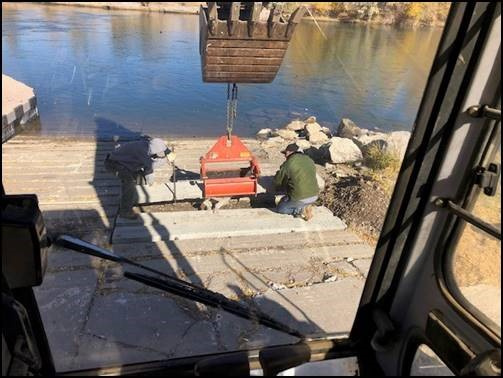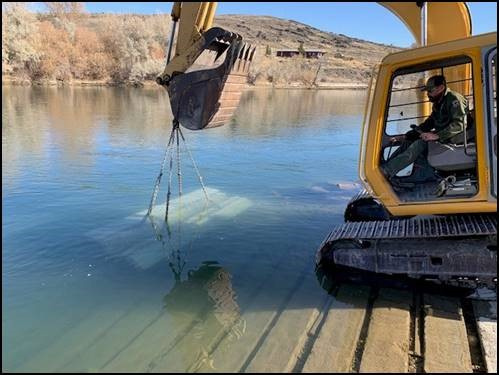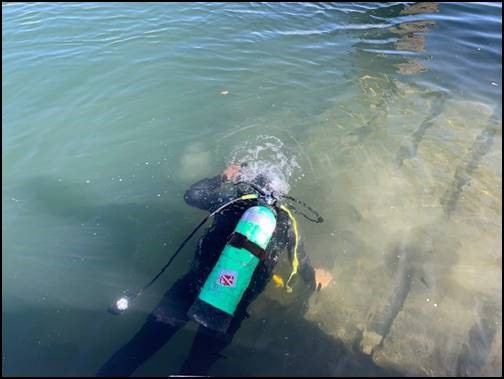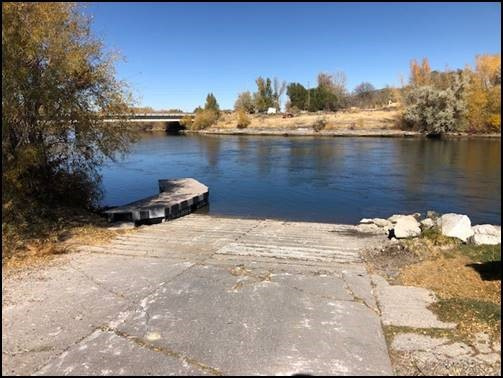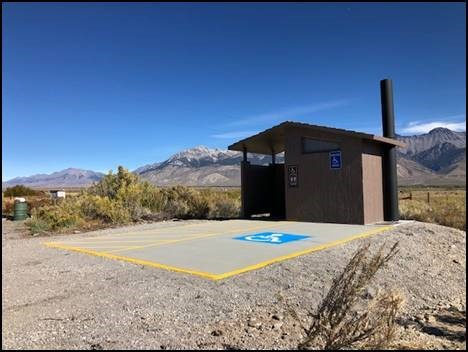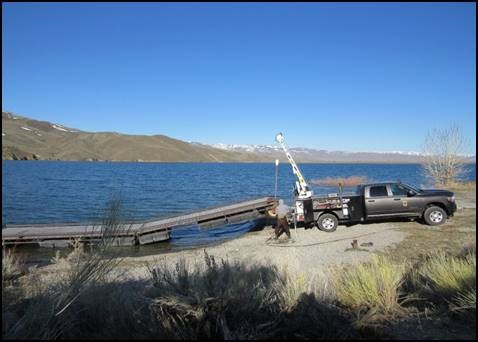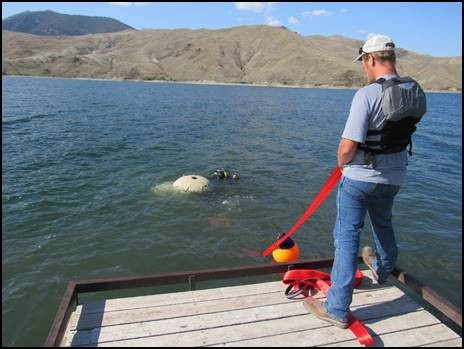Interest in the Henry’s Lake fishery status stretches far and wide. Jenn Vincent, IDF&G Upper Snake River Region’s fisheries biologist is charged with monitoring this status. Here is Jenn’s summary report giving an analysis and tracking of the lake’s 2020 ice fishing, a comparison with past ice fishing seasons and thoughts on the fishery status going into and expected for the 2021 open water season.
Hitting the Hard Water at Henrys Lake
By: Jenn Vincent
Anglers spent a record number of hours fishing the hard deck at Henry’s Lake during the 2020 ice fishing season with over twice the total number of estimated fishing hours than the 2019 ice fishing season. Despite this amount of angling effort, anglers harvested fewer trout during the 2020 ice fishing season than the 2019 season. Anglers harvested 22% of the trout they caught during the 2020 season and caught trout at a rate of 0.40 trout per hour.

Over the past year, COVID-19 has created many challenges for each and every one of us. One thing is for certain, this year has proven how important outdoor opportunities are in helping us all to step away and recharge even if just for a few hours. It was evident that many anglers took the opportunity to get away this winter and fish the hard water at Henry’s Lake.
Henry’s Lake is known internationally for its trophy-sized trout. Anglers have the chance at catching Yellowstone Cutthroat, Hybrid (Yellowstone Cutthroat x Rainbow Trout), and Brook trout on Henry’s Lake. Although the lake is a great place to visit throughout the year, ice fishing is a great opportunity for anyone to fish without the need of a boat or specialized gear. Anglers can fish with minimal equipment and can access the lake easily by foot or snow machine from various public access points around the lake. It’s a great opportunity for the whole family to get out and try their luck at some trophy-sized trout.
During the 2020 ice fishing season, which lasted from October 26 through midnight on January 1, 2021, we conducted a creel survey to estimate how many hours anglers fished, how many fish they caught, and how many fish were harvested on Henry’s Lake.
In order to collect the necessary information, we interviewed 154 anglers. Most of the anglers we interviewed (80%) were Idaho residents.
Anglers caught an estimated total of 27,756 trout over the season and harvested an estimated 6,175 of these fish. Anglers harvested 22% of the trout that they caught. Yellowstone Cutthroat Trout was the most commonly captured trout at 46% of the catch, followed by Hybrid Trout at 42%, and Brook Trout at 12%.
Anglers fished the hard water this past year for an estimated total of 69,144 hours over the entire ice fishery. This compares to 34,511 hours during the 2019 ice fishery (Table 1). The total number of trout caught and harvested this season is most closely comparable to the 2013 survey although the 2013 catch rate is three times higher than observed in 2020.
Table 1. Estimated total angler hours, total trout caught, total trout harvested, percentage of total trout harvested (%), and season catch rate (total number of trout caught/hour) for the 2013, 2016, 2018, 2019, and 2020 ice fishing seasons.
|
Year |
|
2013 |
2016 |
2018 |
2019 |
2020 |
| Tot. angler hours |
21,833 |
9,354 |
34,556 |
34,511 |
64,144 |
| Tot. trout caught |
25,657 |
962 |
23,099 |
44,006 |
27,756 |
| Tot. trout harvested |
6,046 |
308 |
2,993 |
8,336 |
6,175 |
| % trout harvested |
23.6% |
32.0% |
13.0% |
19.0% |
22.2% |
| Catch rate (trout/hour) |
1.18 |
0.10 |
0.67 |
1.28 |
0.40 |
Anglers caught an estimated 0.40 trout/hour through the ice which is less than the catch rate observed during the 2019 ice fishery which boasted a 1.28 trout/hour (Table 1). Our 2019-2024 Fisheries Management Plan for the state specifies that IDFG manages Henry’s Lake for a goal catch rate of 0.7 fish/hour. Henry’s Lake has had two consecutive good water quantity and quality years attributing to great water conditions, and fishing seasons have responded with good catch rates. We suspect the increase in angling pressure this year was related to recent good catch rates on the lake and impacts from the pandemic.

(Brrrr!)
When compared to the most recent open water fishery survey conducted in 2019, anglers harvested a similar proportion of fish they caught (Table 2). During the open water fishery in 2019, anglers harvested 14% of the fish they caught, while ice anglers during the 2020 season harvested 22%. The 6,175 fish harvested during the 2020 ice fishing season was just 25% of the fish harvested during the 2019 open water season, and harvest occurred at a higher rate during the open water season of 2019 (Table 2). Anglers during the 2019 open water season harvested one fish for every 7.1 hours of fishing effort while anglers during the 2020 ice fishing season harvested a trout for every 11.1 hours of fishing. Henry’s Lake anglers released most of the fish they caught during both years, and the number of fish harvested is lower than the number required to result in negative impacts to the population number or average fish size in the lake. The average length of harvested trout during the 2020 ice fishing season was 18 inches for both Brook Trout (BKT) and Yellowstone Cutthroat Trout (YCT), and 19 inches for Hybrid Trout (HYB) with the largest HYB measuring 24.6 inches in length. Harvested trout checked in by creel clerks this season were comparable to the trout checked in the 2019 open water fishery which averaged 16 inches for BKT and 18 inches for both YCT, and HYB. Last season we had a large age-2 class of trout in the population. These fish are likely still the trout being harvested in 2020 although they have had an additional year to grow following the 2019 open water fishery.
Table 2. Creel survey results including season length (day), total angler effort (hours), total trout caught, total trout harvested, and catch rate (trout per hour) for the 2019 open water fishery (May 25 through October 29, 2019) and 2020 ice fishery (October 26, 2020 through January 1, 2021) on Henry’s Lake.
|
2019 Open water Fishery |
2020 Ice Fishery |
|
May 25 – Oct. 29, 2019 |
Oct. 26, 2020 – Jan. 1, 2021 |
| Season length (day) |
158 |
67 |
| Total angler effort (hour) |
173,477 |
64,144 |
| Total trout caught |
183,484 |
27,756 |
| Total trout harvested |
24,773 |
6,175 |
| Catch rate (trout/hour) |
1.06 |
0.40 |
IDFG conducts a full season survey of anglers on Henry’s Lake every three years to better understand how the fishery is preforming. Our next season long survey will occur in 2022.

Overall, we estimated a two-fold increase in total angler fishing hours, a harvest rate lower than that observed during a recent open water season, slightly increased size in harvested trout due to increased overall sizes of trout in 2020, and a reduced total catch rate for the 2020 ice fishery on Henry’s Lake. Although the catch rate has decreased this season, Henry’s Lake still provides a unique opportunity for anglers regardless of season, gear type, and experience level to try their hand at pulling in a trophy-sized trout right here in Eastern Idaho.









